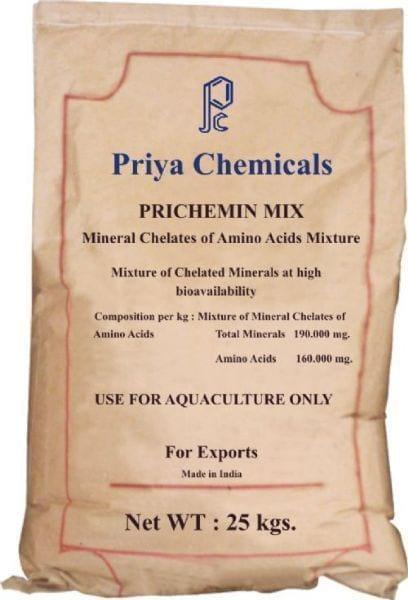Explore all the information on
Aquaculture health
Welcome to the page about Aquaculture health of Engormix; a source of knowledge on Aquaculture health.
Abstract Limiting factors to the tilapia farming industry are numerous and deeply embedded in the environmental paradigm. Infectious diseases are moved to the top list of limiting factors that harshly endangering the fish health with consequent negative impact on the entire population ecology. Antibiotic selection is of major time-wise and economical importance when an episode of bacterial infection has swiftly attacked...
Comments : 0
Recommendations: 0
INTRODUCTION Grouper fish are genera of the subfamily Epinephelinae of the family Serranidae, in the order Perciformes (Cornish and Harmelin-Vivien, 2004). The common name grouper is usually given to fish in one of two large genera: Epinephelus and Mycteroperca (Cornish and Harmelin-Vivien, 2004). Despite the fact that Grouper fish are variable in size, they can be moderately large with maximum...
Comments : 0
Recommendations: 0


PRICHEMIN MIX
Priya's PRICHEMIN MIX is a mineral supplement for aquaculture. It consists of a mix of mineral chelats from aminoacids
Suggested link
Abstract The effect of cadmium (Cd) toxicity and its impact on histopathology, haematological, and biochemical changes in Nile tilapia ( Oreochromius niloticus ) were studied. Fish (35-45 grams) were exposed to Cd that resulted in significant reduction (p< 0.05) of the erythrocyte count (RBCs), haemoglobin content (Hb) and haematocrit value (Hct). Significant increases in plasma aspartate...
Comments : 0
Recommendations: 0
The European model of using vaccination as a primary prophylactic tool was applied successfully to orange-spotted grouper juveniles. This demonstrates a new direction for health management in grouper culture in Asia. Asian aquaculture is characterised by an enormous diversity of species, with several dozen marine fish species being farmed. Consequently, more resources are needed to understand the basic epidemiology of diseases in...
Comments : 3
Recommendations: 0


PRICHEMIN MIX
Priya's PRICHEMIN MIX is a mineral supplement for aquaculture. It consists of a mix of mineral chelats from aminoacids
Suggested link
ABSTRACT The object of this study was to conduct the ability of two medicinal herbs, namely rosemary and parsley, for amelioration of aflatoxicosis in Oreochromis niloticus . Two herbs´ extracts at three concentrations of either (0, 2 and 4 g kg -1 B.W. divided into 2 doses at the start and the 6 th day of the experiment) and three concentrations of aflatoxin B 1 ,...
Comments : 0
Recommendations: 0
In addition to causing widespread flooding, the rains drenching the Midwest this spring may exacerbate another environmental problem - phosphorus and nitrate pollution in the water supply that is causing a growing hypoxic zone in the Gulf of Mexico, presenting a danger to marine life and wildlife habitats, according to recent studies by a team of scientists from the University of Illinois and Cornell University.
The hypoxic...
Comments : 0
Recommendations: 0


PRICHEMIN MIX
Priya's PRICHEMIN MIX is a mineral supplement for aquaculture. It consists of a mix of mineral chelats from aminoacids
Suggested link
With more barramundi being cultured intensively in Asia, extensive epidemiology surveys conducted provide insights into the major diseases. With better understanding of these diseases, industry can look forward to vaccination and other disease management protocols. The barramundi (also known as the Asian seabass Lates calcarifer ) is native to the Indo-Pacific region and is well suited to aquaculture. Although most of the current...
Comments : 0
Recommendations: 0
A European system of immersion followed by injection vaccination is indicated as the strategy of choice in the control of this pathogen. Asian sea bass ( Lates calcarifer ), also known as barramundi, is becoming increasingly popular as a food fish in export markets such as the US and EU. As demand increases, more and more farms are appearing in the South East Asian region to supply these growing markets. Concomitantly with the rise in...
Comments : 0
Recommendations: 0


PRICHEMIN MIX
Priya's PRICHEMIN MIX is a mineral supplement for aquaculture. It consists of a mix of mineral chelats from aminoacids
Suggested link
The worldwide food and drink industry is one of the largest of the manufacturing sectors. It is the largest within the UK, accounting for 15% of all manufacturing and a total turnover of over £70bn (1), which ranks the UK's food and drink industry as fourth in the world (2). Spending on food and drink increases year after year, accounting for a large percentage of customer expenditure. As such a large industry, this sector employs 13% of the UK manufacturing...
Comments : 0
Recommendations: 0
AMR, ZEAH, bacterial floc, heterotrophs, autotrophs – these terms maybe new to the ears of fish and shrimp farmers in the Philippines. AMR stands for Aerated Microbial Reuse while ZEAH stands for Zero-Exchange, Aerobic, Heterotrophic. Both refer to the same thing: a system of intensive aquaculture that has been around for at least ten years and is becoming more popular– starting in the Western hemisphere but now spreading in Southeast Asia. The basic technology was developed at...
Comments : 4
Recommendations: 0


PRICHEMIN MIX
Priya's PRICHEMIN MIX is a mineral supplement for aquaculture. It consists of a mix of mineral chelats from aminoacids
Suggested link
Infectious Myonecrosis Virus causes opacity in the abdominal muscles and necrosis of the tails in various shrimp species. To overcome IMNV-related mortalities in cultured white shrimp, some Brazilian shrimp farmers are testing the southern brown shrimp, Fenneropenaeus subtilis , in growout ponds. Testing found that the virus also affects the brown shrimp. In September 2002,unusual mortality in farmed Pacific white shrimp, Litopenaeus...
Comments : 0
Recommendations: 0
Abstract
Live body weight and daily body gain of Nile tilapia fish decreased significantly (P<0.001) with increasing dietary lead level. Live body weight and daily body gain of Nile tilapia increased significantly with vitamin E or calcium supplementation in diets. Fish fed diets supplemented with calcium recorded higher body weigh and growth rate than the other experimental groups. Daily feed intake...
Comments : 0
Recommendations: 0


PRICHEMIN MIX
Priya's PRICHEMIN MIX is a mineral supplement for aquaculture. It consists of a mix of mineral chelats from aminoacids
Suggested link
Aquaculture is the fastest growing food sector globally and is established itself as high protein resource to fulfill the food demand since the natural resources exhibits over exploitation. But, presently, the biggest problem faced by the aquaculture industry worldwide is diseases caused due to various biological and non-biological agents. Among the groups of microorganisms that cause serious losses in shrimp culture, the best known are bacteria because of...
Comments : 6
Recommendations: 0
What Is a Virus?
Viruses are very small infectious agents that multiply only within the living cells of an animal or plant host. Other microorganisms, such as bacteria or fungi, have organelles for their own metabolism, but viruses do not. They must utilize the machinery of the infected host cell for growth and reproduction.
A virus has two parts. The internal part is the virion, or virus particle which is composed of nucleic acid, the same material that...
Comments : 0
Recommendations: 0


PRICHEMIN MIX
Priya's PRICHEMIN MIX is a mineral supplement for aquaculture. It consists of a mix of mineral chelats from aminoacids
Suggested link
Researchers from Oregon State University, NASA and other organizations said today that they have succeeded for the first time in measuring the physiology of marine phytoplankton through satellite measurements of its fluorescence - an accomplishment that had been elusive for years.
With this new tool and the continued use of the MODIS Aqua satellite, scientists will now be able to gain a reasonably accurate picture of the ocean's health and productivity about every week, all over the...
Comments : 0
Recommendations: 0
In the world of marine mussels and other shellfish bivalves, looks can be deceiving when it comes to health.
"A major problem with bivalve populations is determining whether they're healthy, sick or in-between," said Dr. Helen Gurney-Smith, Research Scientist at Vancouver Island University's Centre for Shellfish Research (CSR).
Most people have heard the expression 'happy as a clam', but the truth is we do not have any "tools" to determine if a clam...
Comments : 0
Recommendations: 0


PRICHEMIN MIX
Priya's PRICHEMIN MIX is a mineral supplement for aquaculture. It consists of a mix of mineral chelats from aminoacids
Suggested link
DNA research at the University of Guelph has provided insight into a perplexing environmental problem on British Columbia's west coast, where fish farms have been blamed for lice epidemics that have devastated wild salmon stocks.
Researchers have long known that fish farms are incubators for lice and that wild salmon stocks in the vicinity of farms, particularly in the Broughton Archipelago off northeast Vancouver Island, have suffered from devastating lice infestations.
But...
Comments : 0
Recommendations: 0
Viral haemorrhagic septicaemia (VHS) is a highly contagious disease of rainbow trout in fresh water, causing great economic loss in the European trout farming industry. In his doctorate, Bjørn Erik Brudeseth presented new findings and methods that explain why some seawater-isolated VHS virus are unable to infect rainbow trout. The VHS virus is known to occur in wild marine fish. The Baltic Sea, for example, has a high incidence of infected fish, in particular...
Comments : 0
Recommendations: 0


PRICHEMIN MIX
Priya's PRICHEMIN MIX is a mineral supplement for aquaculture. It consists of a mix of mineral chelats from aminoacids
Suggested link
As part of the EU funded Fine fish project, Nofima arrange two professional training courses focusing on prevention of malformations in juvenile/adult fish. This workshop is aimed at fish producers, fish health service providers and scientists.
This workshop does not only present results but also provide hands-on training for the benefit of hatchery and juvenile farm operators. The workshop will combine information developed within the project with experience and observations from...
Comments : 0
Recommendations: 0
Researchers funded by the Biotechnology and Biological Sciences Research Council (BBSRC) have gained a key insight into a disease that is devastating the UK's fish farming industry. The researchers have discovered that fish can harbour and spread proliferative kidney disease (PKD), a cause of major stock losses on fish farms, as well as being affected by the infection.
The discovery now paves the way for research to develop effective ways to combat the disease. The research was...
Comments : 0
Recommendations: 0





